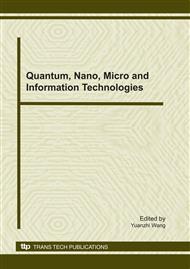p.140
p.146
p.151
p.157
p.163
p.169
p.176
p.182
p.186
Design and Analysis of a Novel Tunable Band-Stop Filter Using RF MEMS Technology
Abstract:
This paper presents a tunable band-stop filter within frequency ranges of 15-30 GHz, it used a novel method to turn the resonant frequency by micro-electromechanical systems (MEMS) switch and coplanar-waveguide (CPW) structures. The DC voltage is utilized to load RF-MEMS switch as source of the tunable cell’s power. The simulation obtained by HFSS and ADS tool shows that insertion loss is less than 1dB in pass-band and return loss is greater than 10 dB. The center frequency changes from 15.5 GHz to 26 GHz, which has 10.5 GHz adjustable range. The result shows good stop rejection and sharp roll off frequency and the extracted result from the circuit matches simulation result very well in this paper.
Info:
Periodical:
Pages:
163-168
Citation:
Online since:
November 2010
Authors:
Price:
Сopyright:
© 2011 Trans Tech Publications Ltd. All Rights Reserved
Share:
Citation:


